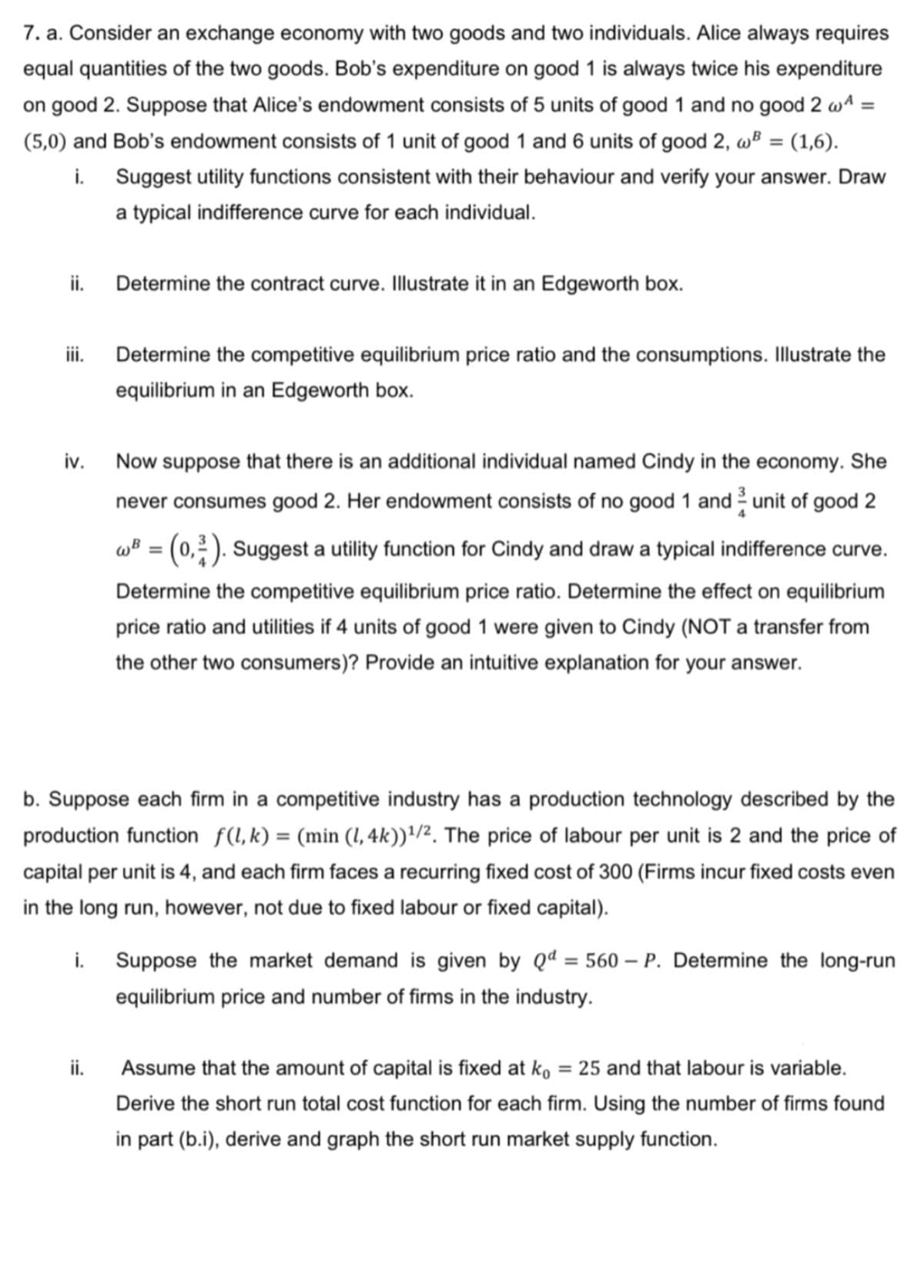7. a. Consider an exchange economy with two goods and two individuals. Alice always requires equal quantities of the two goods. Bob's expenditure on good 1 is always twice his expenditure on good 2. Suppose that Alice's endowment consists of 5 units of good 1 and no good 2 wA = (5,0) and Bob's endowment consists of 1 unit of good 1 and 6 units of good 2, w® = (1,6). i. Suggest utility functions consistent with their behaviour and verify your answer. Draw a typical indifference curve for each individual.
7. a. Consider an exchange economy with two goods and two individuals. Alice always requires equal quantities of the two goods. Bob's expenditure on good 1 is always twice his expenditure on good 2. Suppose that Alice's endowment consists of 5 units of good 1 and no good 2 wA = (5,0) and Bob's endowment consists of 1 unit of good 1 and 6 units of good 2, w® = (1,6). i. Suggest utility functions consistent with their behaviour and verify your answer. Draw a typical indifference curve for each individual.
Chapter13: General Equilibrium And Welfare
Section: Chapter Questions
Problem 13.5P
Related questions
Question
Any parts appreciated the more the better.

Transcribed Image Text:7. a. Consider an exchange economy with two goods and two individuals. Alice always requires
equal quantities of the two goods. Bob's expenditure on good 1 is always twice his expenditure
on good 2. Suppose that Alice's endowment consists of 5 units of good 1 and no good 2 w4 =
(5,0) and Bob's endowment consists of 1 unit of good 1 and 6 units of good 2, wB = (1,6).
i. Suggest utility functions consistent with their behaviour and verify your answer. Draw
a typical indifference curve for each individual.
ii.
Determine the contract curve. Illustrate it in an Edgeworth box.
ii.
Determine the competitive equilibrium price ratio and the consumptions. Illustrate the
equilibrium in an Edgeworth box.
iv.
Now suppose that there is an additional individual named Cindy in the economy. She
never consumes good 2. Her endowment consists of no good 1 and unit of good 2
wB = (0,2). Suggest a utility function for Cindy and draw a typical indifference curve.
Determine the competitive equilibrium price ratio. Determine the effect on equilibrium
price ratio and utilities if 4 units of good 1 were given to Cindy (NOT a transfer from
the other two consumers)? Provide an intuitive explanation for your answer.
b. Suppose each firm in a competitive industry has a production technology described by the
production function f(l,k) = (min (I, 4k))'/2. The price of labour per unit is 2 and the price of
capital per unit is 4, and each firm faces a recurring fixed cost of 300 (Firms incur fixed costs even
in the long run, however, not due to fixed labour or fixed capital).
Suppose the market demand is given by Qd = 560 – P. Determine the long-run
equilibrium price and number of firms in the industry.
i.
ii.
Assume that the amount of capital is fixed at ko = 25 and that labour is variable.
Derive the short run total cost function for each firm. Using the number of firms found
in part (b.i), derive and graph the short run market supply function.
Expert Solution
This question has been solved!
Explore an expertly crafted, step-by-step solution for a thorough understanding of key concepts.
This is a popular solution!
Trending now
This is a popular solution!
Step by step
Solved in 2 steps with 1 images

Knowledge Booster
Learn more about
Need a deep-dive on the concept behind this application? Look no further. Learn more about this topic, economics and related others by exploring similar questions and additional content below.Recommended textbooks for you


Principles of Microeconomics
Economics
ISBN:
9781305156050
Author:
N. Gregory Mankiw
Publisher:
Cengage Learning


Principles of Microeconomics
Economics
ISBN:
9781305156050
Author:
N. Gregory Mankiw
Publisher:
Cengage Learning